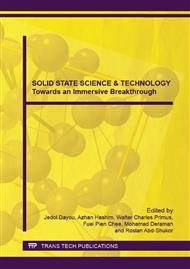p.678
p.687
p.693
p.699
p.706
p.712
p.716
p.722
p.727
ZT Measurements of Thermoelements under Large Temperature Difference
Abstract:
The thermoelectric dimensionless figure-of-merit, ZT, which consists of the Seebeck coefficient, α, electrical resistivity, ρ and thermal conductivity, λ, is an important parameter that characterizes the energy conversion performance of thermoelectric materials and devices. Current techniques for determining ZT involve measurements these three properties individually or ZT directly, but all techniques are carried out under a small temperature difference (ΔT). In reality, a thermoelectric device generally operates under a much larger ΔT and with an electrical current flowing through the thermoelectric materials. A novel principle for ZT measurement has been proposed, which has the capability of measuring ZT values under a large ΔT and with an electrical current flowing through the samples. Although this technique has been proof experimentally using thermoelectric module, its implementation on thermoelement has proved to be very challenging due to low electrical resistance of the samples. In this paper, newly develop apparatus with a modified operating principle was proposed and carried out. The performance of this system was investigated using a standard n-type Bi2Te3 sample. The results show that the system has a repeatability of <10% and an accuracy of 13-32%. Investigation on single materials structures showed that there were noticeable differences between a small and a large ΔT, which can be attributed to the Thomson effect and changes in ρλ values.
Info:
Periodical:
Pages:
716-721
Citation:
Online since:
June 2015
Authors:
Price:
Сopyright:
© 2015 Trans Tech Publications Ltd. All Rights Reserved
Share:
Citation:


